Newmarket, Cambridgeshire
Up to 1834
Burwell had a parish workhouse from 1736 (Hampson, 1934). A parliamentary report in 1777 recorded local workhouses in operation at Burwell (for up to 20 inmates), Dalham (14), Wood Ditton (30), Isleham (30), Soham (60), and Wicken (28).
Dullingham had workhouses in at least two different buildings. The Guildhall, on what is now Station Road, which dates back to before 1500, was used in the eighteenth century.
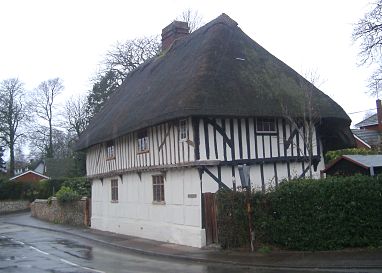
Dullingham Guildhall, 2003.
© Peter Higginbotham.
A later Dullingham workhouse was in a building on Brinkley Road.
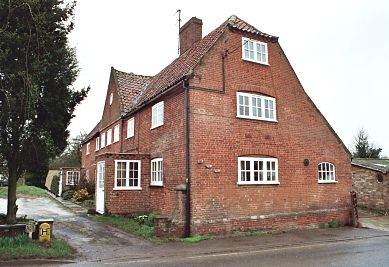
Dullingham Brinkley Road workhouse, 2003.
© Peter Higginbotham.
After 1834
Newmarket Poor Law Union was formed on 30th December, 1835. Its operation was overseen by an elected Board of Guardians, 36 in number, representing its 29 constituent parishes as listed below (figures in brackets indicate numbers of Guardians if more than one):
Cambridgeshire:
Ashley-cum-Silverley, Borough Green, Bottisham (2), Brinkley, Burwell (2), Cheveley, Chippenham, Dullingham, Fordham (2), Isleham (2), Kennet, Kirtling, Landwade, Newmarket - All Saints, Snailwell, Soham (3), Steckworth, Swaffham Bulbeck, Swaffham Prior, Westley, Wicken, Wood Ditton.
Suffolk:
Dallham, Exning, Gazeley, Moulton, Ousden, Newmarket - St Mary's (2), Sidgate.
The population falling within the Union at the 1831 census had been 24,590 — ranging from Landwade (population 46) to Soham (3,667). The average annual poor-rate expenditure for the period 1834-36 had been £18,191 or 14s.11d. per head.
Newmarket Union workhouse was erected in 1837 on the north side of Exning Road in Newmarket. Built in white brick with slate roofs, it was designed by William P Roote who was also responsible for the union workhouses at Newport Pagnell and Leighton Buzzard.
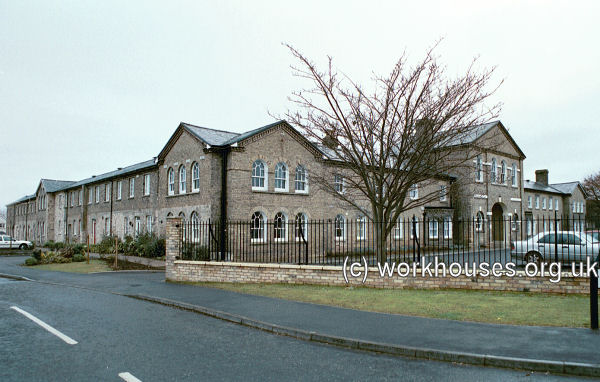
Former Newmarket workhouse — general view from the west, 2001.
© Peter Higginbotham.
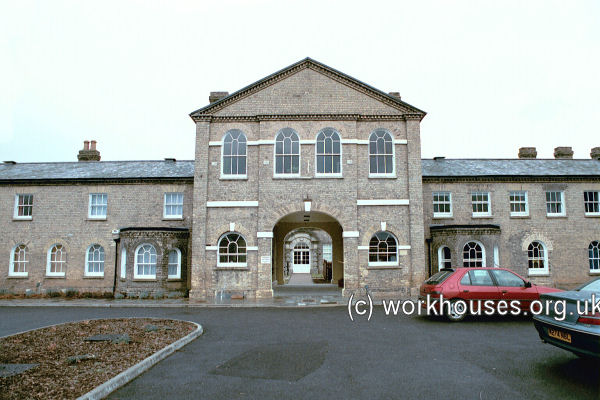
Former Newmarket workhouse — main entrance, 2001.
© Peter Higginbotham.
The location and layout of the workhouse are shown on the 1901 map below:
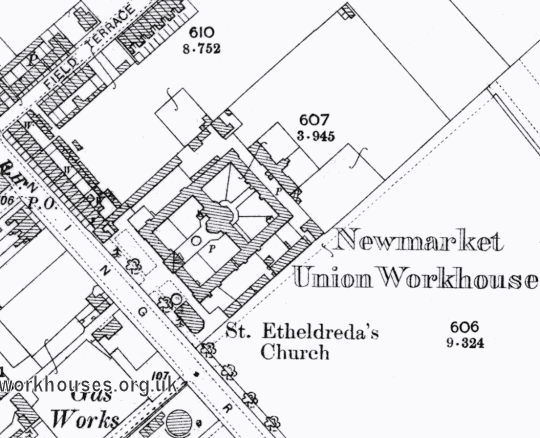
Newmarket workhouse site, 1901.
Its plan consisted of four two-storey ranges forming a rectangle, with the inner courtyard divided in two by single-storey passageways meeting at a central administrative block. A small infirmary lay at the north-east of the main building.
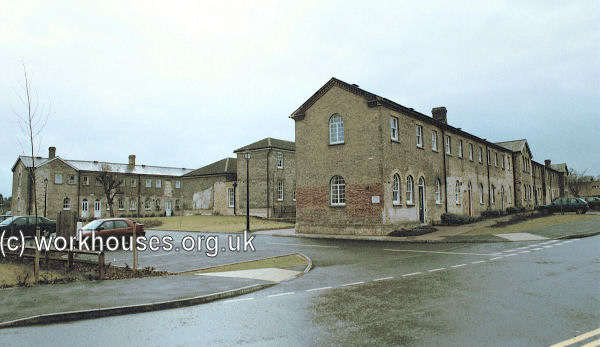
The former Newmarket workhouse from the north, 2001.
© Peter Higginbotham.
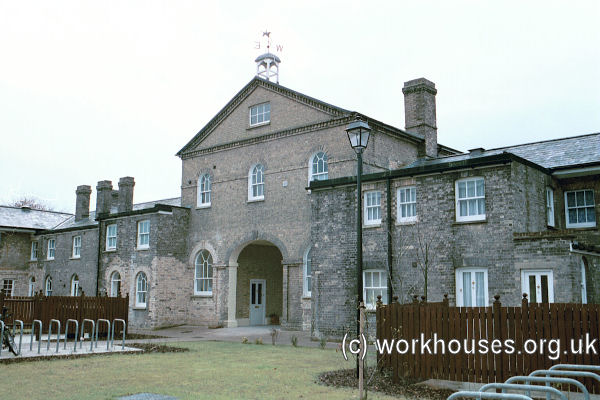
The former Newmarket workhouse — rear of entrance block from the north, 2001.
© Peter Higginbotham.
In 1846, Newmarket workhouse was the subject of a famous verse-letter to his sister by James Reynolds Withers.
A workhouse chapel, dedicated to St Etheldreda, was erected in 1895 at the south of the site. It could hold up to 250 worshippers. A choir of outside boys and men in cassocks and surplices provide the music free for the services each Sunday, which were attended by outsiders as well as the inmates.
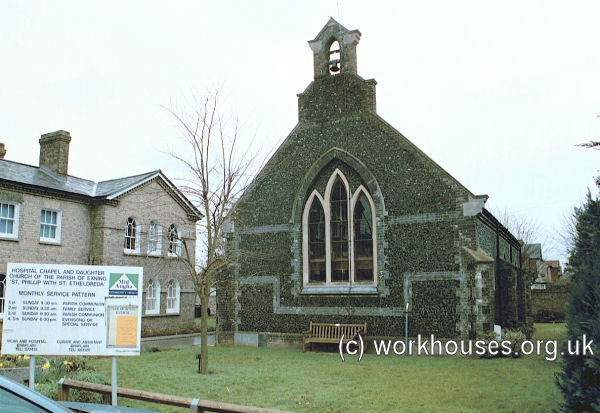
The former Newmarket workhouse — St Etheldreda's chapel from the north-west, 2001.
© Peter Higginbotham.
A large new infirmary was erected at the north-east of the workhouse in 1902-3 at a total cost of almost £30,000. It was connected by a corridor to the centre of the existing building, which was also remodelled.
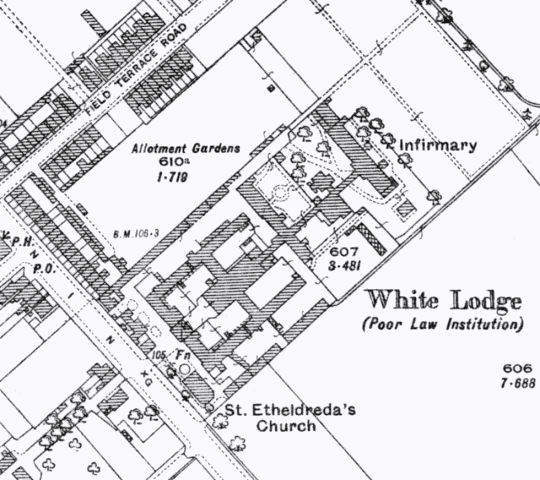
Newmarket workhouse site, 1926.
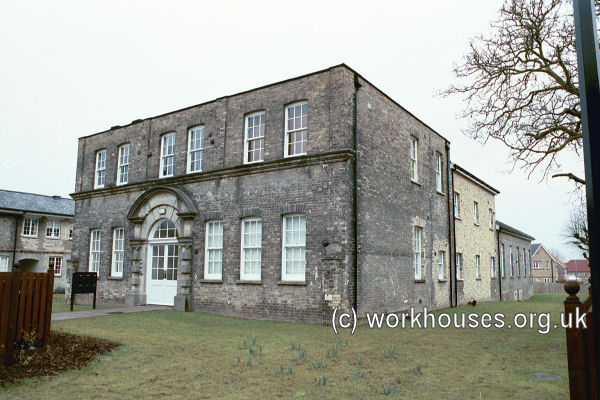
Former Newmarket workhouse — central hub from the south after construction of new infirmary, 2001.
© Peter Higginbotham.
On July 13th, 1904, King Edward VII visited the workhouse, one of the few such visits by a British monarch. One small incident that was reported in the press took place in the men's ward. A bed-bound stable lad named John Watts who was suffering from consumption (tuberculosis of the lungs) was asked by the King whether he could play a mandolin which lay nearby. The young man, an orphan, was too confused to answer. However, the workhouse master said he thought the boy would like to try and play 'God Save the King' on the instrument. 'With a kindly smile and word which set the little fellow at ease his Majesty bade hint do his best, and he stood bareheaded by the sick bed while the lad essayed the task. The King delighted the lad by saying he had played very well.'
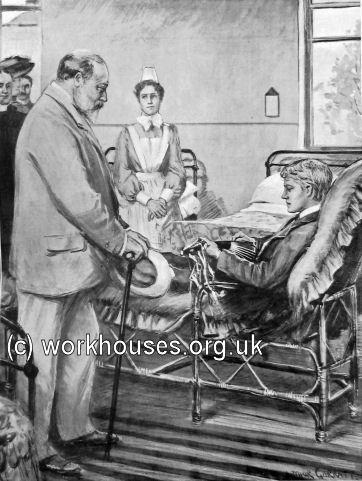
The royal visit to Newmarket workhouse, 1904.
© Peter Higginbotham.
The Newmarket workhouse later became the White Lodge Hospital but the site has now been redeveloped for residential use.
Staff
Inmates
Records
Note: many repositories impose a closure period of up to 100 years for records identifying individuals. Before travelling a long distance, always check that the records you want to consult will be available.
- Suffolk Archives, 77 Raingate Street, Bury St Edmunds IP33 2AR. Very few local records survive.
Bibliography
- Hampson, E.M. (1934) The Treatment of Poverty in Cambridgeshire, 1597-1834 (Cambridge Studies in Economic History; CUP).
Links
- None.
Unless otherwise indicated, this page () is copyright Peter Higginbotham. Contents may not be reproduced without permission.


